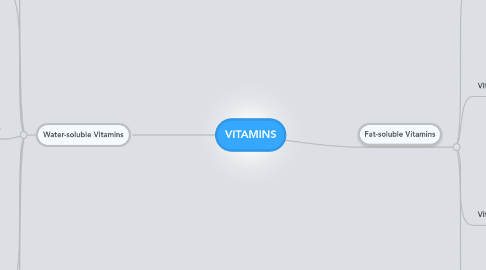
1. Water-soluble Vitamins
1.1. Vitamin B1 (Thiamin)
1.1.1. Toxicity: None known
1.1.2. Deficiencies: Beriberi
1.1.3. Sources: Meat, soya beans, peas, cereals, nuts, mushrooms.
1.1.4. Functions: Helps to breakdown food into energy, needed for normal functioning of nerves.
1.2. Vitamin B2 (Riboflavin)
1.2.1. Functions: Helps in the release of energy from food, needed for growth and development.
1.2.2. Sources: Dairy products, eggs, meat, liver, soya beans, green leafy vegetables.
1.2.3. Deficiencies: Ariboflavinosis.
1.2.4. Toxicity: None known
1.3. Vitamin B3 (Niacin)
1.3.1. Functions: Helps in the release of energy from carbohydrates and fats.
1.3.2. Sources: Meat, fish, poultry, potatoes, whole-grain food, liver.
1.3.3. Deficiencies: Pellagra.
1.3.4. Toxicity: Flushing of skins, tingling sensation in hand and feet, liver damage, blurred vision.
1.4. Vitamin B6 (Pyridoxine)
1.4.1. Functions: Needed to produce and breakdown amino acid.
1.4.2. Sources: Whole-grain food, meat, fish, poultry, potatoes, liver.
1.4.3. Deficiencies: Numbness in hands and feet, dermatitis, anaemia, convulsion.
1.4.4. Toxicity: Nerve damage, skin lesions.
1.5. Vitamin B9 (Folate/Folic acid)
1.5.1. Functions: Helps in the release of amino acids, helps to form new cells and genetic materials (DNA), works with vitamin B12 to produce red blood cells.
1.5.2. Sources: Milk, cereals, liver, green leafy vegetables, citrus fruits, whole-grain food.
1.5.3. Deficiencies: Anaemia, spina bifida in babies, premature and low birth weight babies.
1.5.4. Toxicity: None known
1.6. Vitamin B12 (Cobalamin)
1.6.1. Functions: Needed to form red blood cells, needed for normal functioning of nerves, needed to maintain the enzymes system.
1.6.2. Sources: Dairy products, meat, poultry, fish, eggs.
1.6.3. Deficiencies: Pernicious, anaemia.
1.6.4. Toxicity: None known
1.7. Vitamin C (Ascorbic acid)
1.7.1. Functions: Acts as an antioxidant, needed to form proteins, helps the body to absorb iron from cereals and dark green vegetables.
1.7.2. Sources: Citrus fruits, guava, honeydew, cauliflower, cabbage, spinach.
1.7.3. Deficiencies: Scurvy.
1.7.4. Toxicity: Diarrhoea, nausea, abdominal cramps, formation of kidney stones.
2. Fat-soluble Vitamins
2.1. Vitamin A (Retinol)
2.1.1. Functions: Needed for healthy vision and skin. Needed for growth and development.
2.1.2. Sources: Liver, oily fish, milk, egg yolk.
2.1.3. Deficiencies: Night blindness, dry and rough skin, poor growth in children.
2.1.4. Toxicity: Fatigue, painful joints, birth defects in babies, nausea and diarrhoea.
2.2. Vitamin D (Cholecalciferol)
2.2.1. Functions: Helps to form strong bones and teeth, helps the body to absorb calcium and phosphorus.
2.2.2. Sources: Oily fish, milk, liver, egg yolk.
2.2.3. Deficiencies: Rickets in children, osteomalacia in adults, week bones and teeth.
2.2.4. Toxicity: Hypercalcemia.
2.3. Vitamin E (Tocopherol)
2.3.1. Functions: Acts as an antioxidant, for healthy nerves and muscles.
2.3.2. Sources: Vegetable oils, whole-grain food,egg yolk, nuts, livers.
2.3.3. Deficiencies: Rare
2.3.4. Toxicity: Rare
2.4. Vitamin K (Naphthoquinone)
2.4.1. Functions: Helps blood to clot properly.
2.4.2. Sources: Liver, green leafy vegetables, legumes, vegetable oils.
2.4.3. Deficiencies: Blood is not able to clot properly.
2.4.4. Toxicity: Rare
